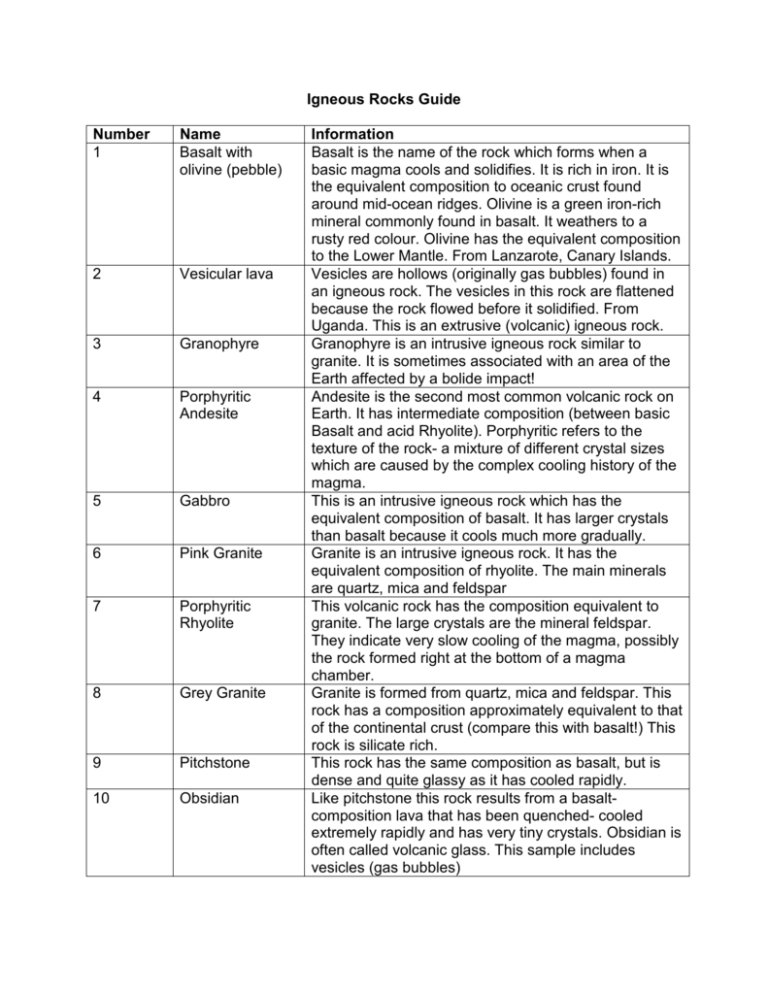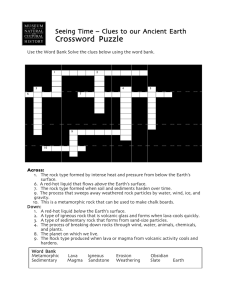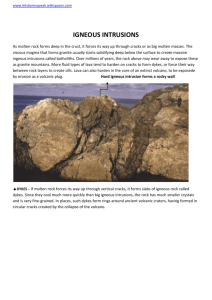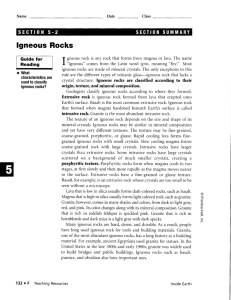Igneous Rocks Specimen Guide - Sedgwick Museum of Earth
advertisement

Igneous Rocks Guide Number 1 Name Basalt with olivine (pebble) 2 Vesicular lava 3 Granophyre 4 Porphyritic Andesite 5 Gabbro 6 Pink Granite 7 Porphyritic Rhyolite 8 Grey Granite 9 Pitchstone 10 Obsidian Information Basalt is the name of the rock which forms when a basic magma cools and solidifies. It is rich in iron. It is the equivalent composition to oceanic crust found around mid-ocean ridges. Olivine is a green iron-rich mineral commonly found in basalt. It weathers to a rusty red colour. Olivine has the equivalent composition to the Lower Mantle. From Lanzarote, Canary Islands. Vesicles are hollows (originally gas bubbles) found in an igneous rock. The vesicles in this rock are flattened because the rock flowed before it solidified. From Uganda. This is an extrusive (volcanic) igneous rock. Granophyre is an intrusive igneous rock similar to granite. It is sometimes associated with an area of the Earth affected by a bolide impact! Andesite is the second most common volcanic rock on Earth. It has intermediate composition (between basic Basalt and acid Rhyolite). Porphyritic refers to the texture of the rock- a mixture of different crystal sizes which are caused by the complex cooling history of the magma. This is an intrusive igneous rock which has the equivalent composition of basalt. It has larger crystals than basalt because it cools much more gradually. Granite is an intrusive igneous rock. It has the equivalent composition of rhyolite. The main minerals are quartz, mica and feldspar This volcanic rock has the composition equivalent to granite. The large crystals are the mineral feldspar. They indicate very slow cooling of the magma, possibly the rock formed right at the bottom of a magma chamber. Granite is formed from quartz, mica and feldspar. This rock has a composition approximately equivalent to that of the continental crust (compare this with basalt!) This rock is silicate rich. This rock has the same composition as basalt, but is dense and quite glassy as it has cooled rapidly. Like pitchstone this rock results from a basaltcomposition lava that has been quenched- cooled extremely rapidly and has very tiny crystals. Obsidian is often called volcanic glass. This sample includes vesicles (gas bubbles) 11 Volcaniclastic rock 12 Breadcrust bomb (small piece, margin) 13 Gabbro and granite contact 14 Dolerite 15 16 Pumice Olivine crystals 17 Rhyolite 18 Weakly consolidated Ash 19 MicroDiorite (Markfieldite This is strictly speaking a sedimentary rock formed by a volcano. Ash and rock fragments from eruptions are thrown high into the atmosphere and settle down to Earth gradually. This rock is formed from ash particles. A blob of gassy, frothy lava was thrown out of a volcano during an eruption. The outer surface cooled rapidly in the air and has a slightly glassy texture. The colour and density means that this has the composition of rhyolite This sample shows two rock types. Both are intrusive igneous rocks, one has cut through the other after it was cooled and solidified. An intrusive igneous rock. Forms the Whin Sill in northern England, divides England from Scotland! Gassy volcanic froth- more hole than rock Olivine is the composition of the Earth's lower mantle. They indicate the bottom of a magma chamber. It is typical of hotspot volcanism (eg Canary Islands, Galapagos Islands) resulting from deep mantle convection This volcanic rock has the composition equivalent to granite. It is an acid lava (rich in silicate) Another volcanic sedimentary rock. Thick ash deposits are formed by explosive volcanic eruptions. Very dangerous type of volcano! A complicated intrusive igneous rock. It is associated with intrusions of granite or gabbro in volcanic arcs. It is formed in a very specific tectonic environment- from the partial melting of mafic (iron-rich) rocks above a subduction zone. It is the equivalent composition to andesite.







